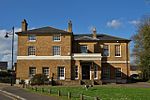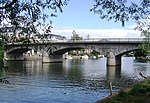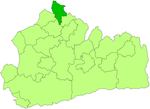Staines-upon-Thames

Staines-upon-Thames is a market town in northwest Surrey, England, around 17 miles (28 kilometres) west of central London. It is in the Borough of Spelthorne, at the confluence of the River Thames and Colne. Historically part of Middlesex, the town was transferred to Surrey in 1965. Staines is close to Heathrow Airport and is linked to the national motorway network by the M25 and M3. The earliest evidence of human activity in the area is from the Paleolithic and, during the Neolithic, there was a causewayed enclosure on Staines Moor. The first bridge across the Thames at Staines is thought to have been built by the Romans and there was a settlement in the area around the modern High Street by the end of the 1st century CE. Throughout the Middle Ages, Staines was primarily an agricultural settlement and was held by Westminster Abbey. The first surviving record of a market is from 1218, but one may have taken place near St Mary's Church in the Anglo-Saxon period. The industrialisation of Staines began in the mid-17th century when Thomas Ashby established a brewery in the town. Improvements to the local transport network in the mid-19th century also stimulated an expansion of the local population. The current Staines Bridge, designed by George Rennie, was opened in 1832 by William IV and the first railway line through Staines opened in 1848. The town became a centre for linoleum manufacture in 1864, when Frederick Walton established a factory on the site of the 13th-century Hale Mill. At the end of the 20th century, Staines became infamous as the home town of the fictional film and television character, Ali G. Although many local residents felt that the town's reputation was suffering through its association with the character, Sacha Baron Cohen, the creator of Ali G, praised Staines for being a "lovely, leafy, middle-class suburb... where swans swim under the beautiful bridge". Partly in response to the reaction to the character, Spelthorne Borough Council voted in 2011 to add the suffix "upon-Thames" to the name.
Excerpt from the Wikipedia article Staines-upon-Thames (License: CC BY-SA 3.0, Authors, Images).Staines-upon-Thames
High Street, Borough of Spelthorne
Geographical coordinates (GPS) Address Nearby Places Show on map
Geographical coordinates (GPS)
| Latitude | Longitude |
|---|---|
| N 51.434 ° | E -0.511 ° |
Address
Barclays
High Street
TW18 4DP Borough of Spelthorne
England, United Kingdom
Open on Google Maps








